Republic Day (India)
| Republic Day | |
|---|---|
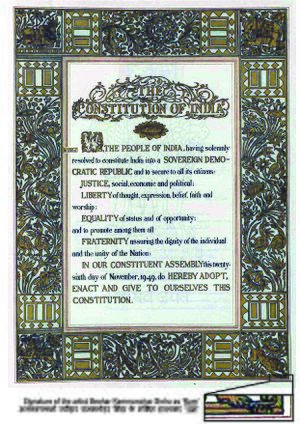 The original text of the Preamble to the Constitution of India. The Constitution of India came into force on 26 January 1950. | |
| Observed by |
|
| Type | National |
| Significance | Inception of Constitution of India |
| Celebrations | Parades, distribution of sweets in schools, speeches and cultural dances |
| Date | 26 January |
| Next time | 26 January 2019 |
| Frequency | Annual |
Republic Day honours the date on which the Constitution of India came into effect on 26 January 1950 replacing the Government of India Act (1935) as the governing document of India.[1]
The Constitution was adopted by the Indian Constituent Assembly on 26 November 1949, and came into effect on 26 January 1950 with a democratic government system, completing the country's transition towards becoming an independent republic. 26 January was chosen as the Republic day because it was on this day in 1930 when Declaration of Indian Independence (Purna Swaraj) was proclaimed by the Indian National Congress as opposed to the Dominion status offered by British Regime.
History of Republic Day
India achieved independence from British Raj on 15 August 1947 following the Indian independence movement noted for largely peaceful non-violent resistance and civil disobedience led by Mahatma Gandhi. The independence came through the Indian Independence Act 1947 (10 & 11 Geo 6 c 30), an Act of the Parliament of the United Kingdom that partitioned British India into the two new independent Dominions of the British Commonwealth (later Commonwealth of Nations).[2] India obtained its independence on 15 August 1947 as a constitutional monarchy with George VI as head of state and the Earl Mountbatten as governor-general. The country, though, did not yet have a permanent constitution; instead its laws were based on the modified colonial Government of India Act 1935. On 28 August 1947, the Drafting Committee was appointed to draft a permanent constitution, with Dr B R Ambedkar as chairman. While India's Independence Day celebrates its freedom from British Rule, the Republic Day celebrates the coming into force of its constitution. A draft constitution was prepared by the committee and submitted to the Constituent Assembly on 4 November 1947.[3] The Assembly met, in sessions open to public, for 166 days, spread over a period of two years, 11 months and 18 days before adopting the Constitution. After many deliberations and some modifications, the 308 members of the Assembly signed two hand-written copies of the document (one each in Hindi and English) on 24 January 1950. Two days later which was on 26 January 1950, it came into effect throughout the whole nation.On that day began Dr. Rajendra Prasad's first term of office as President of the Indian Union. The Constituent Assembly became the Parliament of India under the transitional provisions of the new Constitution.This date is celebrated in India as the Republic Day.
Celebrations
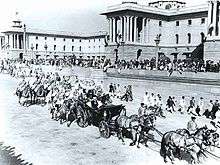
The main Republic Day celebration is held in the national capital, New Delhi, at the Rajpath before the President of India. On this day, ceremonious parades take place at the Rajpath, which are performed as a tribute to India; its unity in diversity and rich cultural heritage.
Delhi Republic Day parade
Delhi Republic Day parade is held in the capital, New Delhi organised by the Ministry of Defence. Commencing from the gates of the Rashtrapati Bhavan (the President's residence), Raisina Hill on Rajpath past the India Gate, this event is the main attraction of India's Republic Day Celebrations lasting three days. The parade showcases India's Defence Capability, Cultural and Social Heritage.[4]
Nine to twelve different regiments of the Indian Army in addition to the Navy, and Air Force with their bands march past in all their finery and official decorations. The President of India who is the Commander-in-Chief of the Indian Armed Forces, takes the salute. Twelve contingents of various para-military forces of India and other civil forces also take part in this parade.[5]
Beating Retreat
The Beating Retreat ceremony is held after officially denoting the end of Republic Day festivities. It is conducted on the evening of 29 January, the third day after the Republic Day. It is performed by the bands of the three wings of the military, the Indian Army, Indian Navy and Indian Air Force. The venue is Raisina Hill and an adjacent square, Vijay Chowk, flanked by the North and South block of the Rashtrapati Bhavan (President's Palace) towards the end of Rajpath.[6]
The Chief Guest of the function is the President of India who arrives escorted by the (PBG), a cavalry unit. When the President arrives, the PBG commander asks the unit to give the National Salute, which is followed by the playing of the Indian National Anthem, Jana Gana Mana, by the Army. The Army develops the ceremony of display by the massed bands in which Military Bands, Pipe and Drum Bands, Buglers and Trumpeters from various Army Regiments besides bands from the Navy and Air Force take part which play popular tunes like Abide With Me, Mahatma Gandhi's favourite hymn, and Saare Jahan Se Achcha at the end.[7][8][9]
Gallery
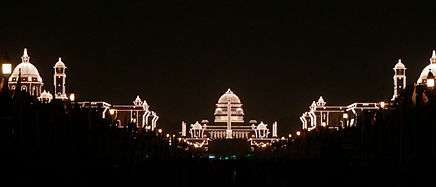 Buildings on Raisina Hill including Rashtrapati Bhavan, lit up during Republic Day 2008.
Buildings on Raisina Hill including Rashtrapati Bhavan, lit up during Republic Day 2008. Surya Kiran Aerobatics Team displaying tricolor.
Surya Kiran Aerobatics Team displaying tricolor.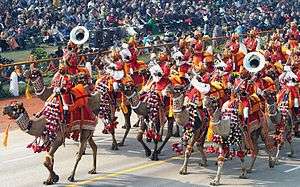 Border Security Force personnel on Republic Day.
Border Security Force personnel on Republic Day.
Republic Day parade chief guest
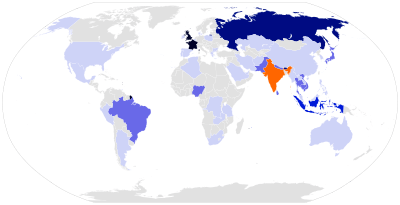
Since 1950, India has been hosting head of state or government of another country as the state guest of honour for Republic Day celebrations in New Delhi. During 1950–1954, Republic Day celebrations were organised at different venues (like Irwin Stadium, Kingsway, Red Fort and Ramlila Grounds). It was only starting 1955 when the parade in its present form was organised at Rajpath.[10] The guest country is chosen after a deliberation of strategic, economic and political interests. During 1950s–1970s, a number of NAM and Eastern Bloc countries were hosted by India. In 1968 and 1974, India played host to two countries on the same Republic Day.
Notes
- 1.^ On each of these occasions, Lady Edwina Mountbatten from United Kingdom was also the official guest for the parade.[16][26]
- 2.^ Duke of Edinburgh Prince Philip also accompanied Queen Elizabeth II during the parade.[23]
- 3.^ Danish Prime Minister attended Republic Day in Madras (Chennai).[63]
- 4.^ No invitations were sent out possibly due to the demise of Prime Minister Lal Bahadur Shastri on 11 January 1966 in Tashkent. The new government headed by Indira Gandhi was sworn on 24 January 1966 (only two days before the Republic Day).[64]
- 5.^ For the first time, the President of India (S. Radhakrishnan) could not take the salute at the Republic Day parade due to ill-health.[65] Zahir Shah arrived on 28 January.[66]
- 6.^ Attended only the Beating Retreat[30][31]
References
- ↑ "Introduction to Constitution of India". Ministry of Law and Justice of India. 29 July 2008. Archived from the original on 22 October 2014. Retrieved 14 October 2008.
- ↑ "Indian Independence Act 1947". The National Archives, Her Majesty's Government. Retrieved 17 July 2012.
- ↑ "Constituent Assembly DEBATES (PROCEEDINGS)". Archived from the original on 29 September 2007. Retrieved 25 January 2014.
- ↑ "India Celebrates 63rd Republic Day". Efi-news.com. Eastern Fare. 26 January 2012. Archived from the original on 15 May 2012.
- ↑ "Chap". Mod.nic.in. Archived from the original on 7 March 2011. Retrieved 22 July 2012.
- ↑ "Republic Day Beating Retreat Ceremony 2017 at Vijay Chowk, New Delhi". DNA India. 29 January 2017. Retrieved 24 January 2018.
- ↑ "Curtain Raiser – Beating Retreat Ceremony 2011". Ministry of Defence. 28 January 2011.
- ↑ "Beating Retreat weaves soul-stirring musical evening". The Times of India. 29 January 2011. Archived from the original on 1 February 2011.
- ↑ "Martial music rings down the curtain". The Times of India. 30 January 2011.
- ↑ "Yog Sandesh Jan-10 English". Scribd.com. Archived from the original on 6 November 2012. Retrieved 24 January 2014.
- ↑ "Republic Day celebrations: President Pranab Mukherjee tweets images from 1950 onwards". 25 July 2017 – via The Economic Times.
- ↑ India, President of (18 January 2015). "King Tribhuvan of Nepal was the guest of honour for the Republic Day in 1951 #26Januarypic.twitter.com/piqaZUKolr".
- ↑ "Selected works of Jawaharlal Nehru" (PDF). claudearpi.net.
- ↑ https://web.archive.org/web/20050205163551/http://www.dawn.com/2005/01/31/fea.htm
- ↑ Rajan, Mannaraswamighala Sreeranga (1964). "India in world affairs, 1954–56".
- 1 2 The Times of India,News Service. (1956, Jan 22). REPUBLIC DAY IN DELHI. The Times of India (1861-Current) Retrieved from https://search.proquest.com/docview/501661043
- ↑ British Pathé (13 April 2014). "Zhukov At India's National Day Aka Zhukov – India (1957)" – via YouTube.
- ↑ Deepak, B. R (2005-01-01). India & China, 1904–2004: A century of peace and conflict. ISBN 9788178271125.
- ↑ "In India, they have been celebrating Republic Day. After the parade..."
- ↑
- ↑ British Pathé (13 April 2014). "Duke Popular Everywhere (1959)" – via YouTube.
- ↑ Prasad, Rajendra (1984). Dr. Rajendra Prasad: Correspondence and Select Documents. ISBN 9788170230021.
- 1 2 "Pandit Jawaharlal Nehru, News Photo, Her Majesty Queen Elizabeth be". Timescontent.com. 1961-01-26. Retrieved 2014-01-24.
- ↑
- ↑ Indian Information. 1962.
- 1 2 British Pathé (13 April 2014). "Republic Celebration (1964)" – via YouTube.
- ↑
- ↑ "visit to New Delhi of Mr Kosygin on the occasion of Republic Day – Google zoeken". Google.com. 2013-11-02. Retrieved 2014-01-24.
- ↑ "Asian Recorder". 1969.
- 1 2
- 1 2 Link: Indian Newsmagazine. 25 July 1970.
- ↑ "India". 1971.
- ↑ "Foreign Affairs Record". 1972.
- ↑ Reed, Sir Stanley (1974). "The Times of India Directory and Year Book Including Who's who".
- ↑ "Indian and Foreign Review". 1973.
- ↑ Lok Sabha (1975). "Lok Sabha Debates".
- ↑ http://www.ambafrance-au.org/france_australie/spip.php?article1521%5Bdead+link%5D
- ↑ "The Eastern Economist". 1977.
- ↑ "Patrick J. Hillery". Clarelibrary.ie. Retrieved 2014-01-24.
- ↑ "Bilateral Visits". Hcindia-au.org. Retrieved 2014-01-24.
- ↑ "MEA | MEA Links : Indian Missions Abroad". Mealib.nic.in. 2013-09-23. Retrieved 2014-01-24.
- ↑ "MEA | MEA Links : Indian Missions Abroad". Mealib.nic.in. 2013-09-23. Retrieved 2014-01-24.
- ↑ "MEA | MEA Links : Indian Missions Abroad". Mealib.nic.in. 2013-09-23. Retrieved 2014-01-24.
- ↑ "MEA | MEA Links : Indian Missions Abroad". Mealib.nic.in. 2013-09-23. Retrieved 2014-01-24.
- ↑ "India Argentina Relations" (PDF). Mea.gov.in. Archived from the original (PDF) on 2010-11-26. Retrieved 2014-01-24.
- ↑ "Annual Report 2000–2001" (PDF). Mea.gov.in. Archived from the original (PDF) on 2010-12-21. Retrieved 2014-01-24.
- ↑ "meacommunity.org". meacommunity.org. Retrieved 2014-01-24.
- ↑ "meacommunity.org". meacommunity.org. Retrieved 2014-01-24.
- ↑ "meacommunity.org". meacommunity.org. Retrieved 2014-01-24.
- ↑
- 1 2 3 4 5 6 7 8 9 10 11 12 13 14 15 16 17 18 "Choosing R-Day chief guest: Behind the warm welcome, a cold strategy". Indian Express. 2010-01-25. Retrieved 2014-01-24.
- ↑ "General South African History timeline" sahistory.org.za Accessed on 13 June 2008.
- ↑ "Choosing R-Day chief guest: Behind the warm welcome, a cold strategy". Indian Express. 2010-01-25. Retrieved 2014-01-24.
- ↑ "Indonesian President next R-Day parade chief guest – Rediff.com India News". News.rediff.com. Retrieved 2014-01-24.
- ↑ "Indonesian President next R-Day parade chief guest – Rediff.com India News". Rediff.com. Retrieved 25 January 2012.
- ↑ New Delhi, 2 Dec (IANS) (20 January 2012). "Thai PM to be chief guest on India's Republic Day". Deccan Herald. Retrieved 25 January 2012.
- ↑ "India invites King of Bhutan as chief guest at Republic Day celebrations". Ibnlive.in.com. 2013-01-26. Retrieved 2014-01-24.
- ↑ "India likely to Japanese Prime Minister Shinzo Abe as Republic Day chief guest : India, News – India Today". Indiatoday.intoday.in. Retrieved 2014-01-24.
- ↑ "Obama in India joins Modi at Delhi Republic Day parade". 26 January 2015 – via www.bbc.com.
- ↑ "French President Hollande invited as Republic Day guest". 22 November 2015.
- ↑ "Abu Dhabi Crown Prince to be chief guest on Republic Day".
- ↑ "India to invite heads of 10 Asean nations for Republic Day celebrations – Times of India".
- ↑ DANISH PREMIER TO VISIT INDIA. (1962, Jan 04). The Times of India (1861-Current) Retrieved from https://search.proquest.com/docview/365725781
- ↑ "Mother India: A Political Biography of Indira Gandhi - Pranay Gupte - Google Books". Books.google.co.in. 2012-02-15. Retrieved 2018-08-01.
- ↑ "Asian Recorder". 25 July 1967 – via Google Books.
- ↑ "Asian Almanac". V.T. Sambandan. 25 July 1967 – via Google Books.
See also
| Wikimedia Commons has media related to Republic Day (India). |